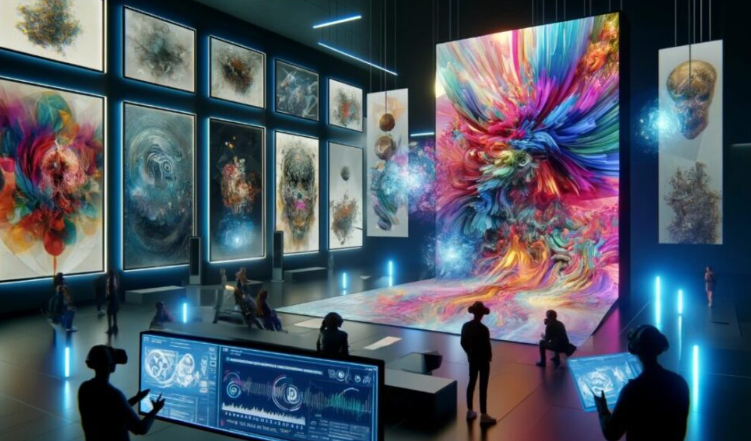The world of digital assets has experienced significant transformations with the advent of blockchain technology. Among these innovations, non-fungible tokens (NFTs) have garnered widespread attention for their ability to represent unique digital ownership. In particular, NFT randomization introduces a new level of excitement and value to these digital assets. This concept enables unpredictability and rarity, fueling the growing NFT market.
This article delves into the fundamental principles of NFT randomization, its significance, real-world applications, and the challenges it faces. We’ll explore how randomization elevates the value of NFTs, particularly in gaming, art, and collectibles, and the solutions for overcoming common hurdles.
What is NFT Randomization?
NFT randomization refers to the integration of random elements during the creation or distribution of NFTs. Unlike traditional NFTs that may be entirely predictable in their characteristics, randomized NFTs introduce a level of uncertainty in traits, features, or abilities. This randomness can influence the rarity, value, and desirability of the NFT, making each one a distinct item within a collection.
How Does NFT Randomization Work?
Randomized NFTs are typically generated through algorithms that assign random attributes to a digital asset. These attributes could include visual traits, abilities, or ownership privileges. The process ensures that each NFT is unique, even within a large collection, adding layers of scarcity that appeal to collectors and investors. The algorithm’s transparency is often verified via blockchain, ensuring fairness and authenticity.
Why Randomization Matters in NFTs
Randomization plays a crucial role in differentiating NFTs from other forms of digital assets. By incorporating random traits, creators can enhance the appeal of their collections, offering buyers the chance to own something truly rare and unpredictable. In gaming, for example, NFT randomization can determine the abilities or powers of characters, giving players a more personalized experience.
The Importance and Benefits of NFT Randomization
NFT randomization isn’t just about creating uniqueness; it also has practical and financial benefits for both creators and collectors.
Enhanced Scarcity and Rarity
Randomization increases the rarity of certain NFTs, driving demand. Since buyers cannot predict the traits of an NFT prior to purchasing it, the potential to own a highly rare piece becomes a compelling incentive. This scarcity often leads to increased market value, as rarer items are typically more valuable.
Increased Engagement for Collectors
For collectors, the thrill of acquiring a randomized NFT is similar to opening a pack of trading cards. They are unaware of what they will receive until the transaction is completed. This “mystery” aspect can keep users engaged for longer periods and encourage them to purchase more NFTs in hopes of acquiring rarer assets.
Fostering Creativity for Artists and Developers
Randomization empowers artists and developers to explore more creative designs. They can implement complex algorithms to generate infinite variations of an artwork, character, or item, enhancing the creative process. This also allows creators to cater to diverse tastes without producing each NFT individually.
Monetization Opportunities
NFT randomization also opens up new monetization strategies. For instance, creators can offer limited-edition drops where rarity is determined by randomization. This unpredictability can create a sense of urgency and scarcity, encouraging buyers to act quickly.
Applications and Use Cases of NFT Randomization
NFT randomization is increasingly applied across various industries, with unique use cases emerging regularly.
Gaming Industry
In gaming, randomization is integral to the success of many NFT-based ecosystems. Game developers often use randomized NFTs to generate characters, items, or land with different attributes. This randomness can affect gameplay, making certain NFTs more powerful or rare than others. Games like Axie Infinity and CryptoKitties have implemented this system to offer unique digital creatures with random traits.
Case Study: Axie Infinity
In Axie Infinity, players breed creatures called Axies. The offspring’s traits are determined through a randomization process, leading to the possibility of rare, highly valuable Axies. This mechanism drives the game’s economy, as players buy, sell, and trade these randomized NFTs.
Digital Art
Digital artists use randomization to create generative art. These artworks are produced through algorithms that assign random characteristics, such as colors, shapes, or patterns. The result is a series of one-of-a-kind pieces that can never be replicated. Art Blocks is a well-known platform that employs this concept, allowing artists to create generative NFT art collections.
Case Study: Art Blocks
Art Blocks uses an algorithm to generate unique pieces of art. Buyers don’t know what the final artwork will look like until they make the purchase, creating a surprise element. Each piece is stored on the Ethereum blockchain, ensuring its rarity and authenticity.
NFT Collectibles
NFT collectibles also rely heavily on randomization. Popular collections like Bored Ape Yacht Club (BAYC) and CryptoPunks use randomization to determine each character’s attributes, such as clothing, accessories, and facial expressions. The more unique or rare these traits are, the more valuable the NFT becomes.
Example: CryptoPunks
Each CryptoPunk is randomly generated with different attributes. Some have rarer features, such as alien or zombie traits, which makes them more sought after by collectors. The randomization of these features has contributed significantly to CryptoPunks’ skyrocketing value.
Challenges in NFT Randomization
While NFT randomization offers many benefits, it also presents certain challenges. These obstacles can impact the fairness, transparency, and overall experience of randomized NFTs.
Lack of Transparency in Algorithms
One concern is the lack of transparency in the algorithms used to randomize NFTs. If buyers feel the process is unfair or manipulated, it could diminish trust in the NFT market. Blockchain technology helps mitigate this by allowing public verification of the randomization process, but not all platforms implement this effectively.
Manipulation of Rarity
Another issue is the potential for creators to manipulate the randomization process. By intentionally limiting the distribution of rare NFTs, creators could artificially inflate prices. This lack of trust can lead to market instability and loss of buyer confidence.
High Gas Fees
The process of minting NFTs, especially randomized ones, can incur high gas fees on platforms like Ethereum. These fees can deter smaller buyers and make the randomization process more costly for creators and collectors alike.
Scalability Issues
As the demand for NFTs grows, scalability becomes a challenge. The more randomized NFTs generated, the more strain is placed on the blockchain network. This can lead to slower transaction times and higher costs, impacting user experience.
Solutions to Overcome NFT Randomization Challenges
Fortunately, several solutions are being explored to address the challenges associated with NFT randomization.
Algorithm Transparency
To build trust, platforms can make their randomization algorithms publicly accessible. This transparency allows buyers to verify the fairness of the process. Decentralized platforms like Chainlink are already offering solutions that provide verifiable randomness for NFT creators, ensuring fair distributions.
Decentralized Platforms for Distribution
Using decentralized platforms for NFT creation and distribution can reduce the risk of manipulation. These platforms ensure that rarity is genuinely random and not artificially inflated, fostering a healthier market environment.
Lower Gas Fees with Layer 2 Solutions
Layer 2 scaling solutions, like Polygon or Immutable X, aim to reduce gas fees and improve transaction speeds for NFT minting. These platforms allow creators and buyers to engage in NFT randomization without the high costs typically associated with Ethereum.
Future of NFT Randomization
NFT randomization is expected to grow in importance as the NFT space evolves. The concept is already making waves in various industries, from gaming to art, and its potential applications are limitless. As technology improves, more sophisticated algorithms will allow for even greater levels of randomness and customization, expanding the possibilities for creators and collectors alike.
Innovations in Randomization Algorithms
Advancements in machine learning and AI could revolutionize NFT randomization. These technologies may allow for more complex trait generation, offering deeper
layers of uniqueness in NFTs. For example, AI-generated NFTs could evolve over time, incorporating new random attributes based on real-world events or user interactions. This dynamic randomization would add a new level of engagement and creativity to the NFT space.
Adoption in Other Industries
Beyond gaming and art, NFT randomization could find applications in industries like real estate, fashion, and music. Imagine randomized NFT fashion pieces, where each garment has unique attributes, or music NFTs where tracks contain randomly generated beats or lyrics. These innovations would expand NFT randomization beyond traditional digital assets.
Conclusion
NFT randomization adds a compelling layer of excitement, unpredictability, and value to the world of non-fungible tokens. By incorporating random traits and attributes into digital assets, creators can offer unique, rare items that engage collectors and buyers alike. Despite the challenges—such as transparency, manipulation, and high fees—solutions like decentralized platforms, verifiable randomness, and Layer 2 scaling technologies are addressing these concerns.
As NFT technology advances, randomization will play an increasingly significant role in shaping the future of digital assets. Whether in gaming, art, or collectibles, NFT randomization opens doors for endless creativity and new market opportunities. For collectors and investors, this unpredictability is a key driver of engagement and long-term value. For more info visit Techno Buzz.
FAQs
- What is NFT randomization?
NFT randomization refers to the process of assigning random traits or attributes to non-fungible tokens during their creation or distribution. This adds uniqueness and increases the rarity and value of the NFTs.
- Why is randomization important for NFTs?
Randomization enhances the appeal and value of NFTs by creating unpredictability. It drives demand for rare items and engages collectors with the thrill of acquiring something unique and potentially valuable.
- How does NFT randomization work in games?
In gaming, NFTs such as characters, items, or abilities are generated with random traits. These random elements can affect gameplay, making some NFTs more powerful or valuable than others.
- What are the challenges of NFT randomization?
Challenges include lack of transparency in randomization algorithms, potential manipulation of rarity, high gas fees for minting NFTs, and scalability issues as demand for NFTs grows.
- How can the NFT randomization process be improved?
Transparency in algorithms, decentralized platforms, and the use of Layer 2 solutions like Polygon and Immutable X are key strategies for improving fairness, reducing costs, and scaling NFT randomization.

